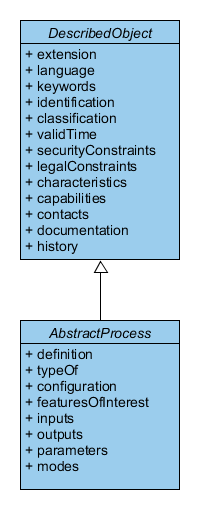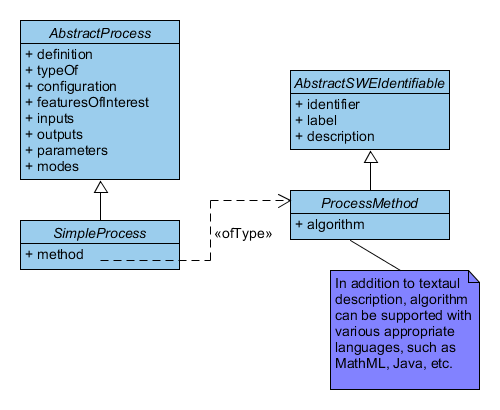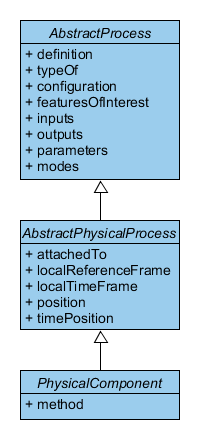3. SensorML
Sensor Model Language
Sensors in general can be classified into the following categories: stationary, mobile, in-situ and remote. Sensors can be installed at a fixed location (stationary) or be mounted on a mobile device to operate in arbitrary locations. In-situ and remote indicate, whether the sensor performs the measurement using local input from within its direct environment (in-situ) or computes measurements for non-local data (remote). In addition, the process, how sensors collect and/or compute data, may vary dramatically from use case to use case. In consequence, a common generic way to describe sensor instances is necessary. To satisfy these various requirements, the OGC developed the Sensor Model Language (SensorML) standard, which can be retrieved as version 2.0 from the URL:
Within the SWE framework, SensorML plays an important role when exchanging metadata about sensors themselves. It represents a uniform description format to describe relevant sensor metadata such as calibration parameters, input/output as well as location definitions, pre- or post-measurement actions/transformations or any other information, which is necessary to correctly interpret and process observations (OGC 2011). Within this scope, a sensor is denoted as a process, which may be a physical or virtual component transforming dedicated input data to one or more outputs via a certain transformation/method. For each degree of complexity, SensorML provides means to describe the whole process metadata in an interoperable way.
According to the standard version 2.0 (Botts & Robin, 2014), a process is modeled as an instance of AbstractProcess class, which denotes an abstract generic set of properties applicable for various processes. It inherits several metadata elements from the class DescribedObject, as shown in the below figure. Note that the figure is simplified compared to the official standard:

From simple hardware devices that measure natural phenomena like temperature, up to complex computational processes, which take several inputs and produce one or more outputs, the SensorML standard offers generic metadata elements. As seen in the above figure, several base metadata elements like identification, keywords, contacts or validTime are inherited from DescribedObject. AbstractProcess comprises additional process-related properties including sensor configuration (settings/calibration), inputs and outputs as well as other parameters or modes. In addition, references to the featuresOfInterest can be stored. Instances of AbstractProcess (e.g. SimpleProcess) have to define a method property, describing the algorithm, how input data is transformed to output data, as modeled according to the following figure.

While the presented SimpleProcess is useful to model (virtual) computations, physical sensors can be defined according to the below figure. Compared to a virtual process, additional information about location and temporal aspects of the sensor can be set. If the single process is only part of a composed process, then this may be reflected in the attachedTo property.

To illustrate this quite abstract description, a concrete example shall demonstrate how to model sensor/procedure metadata within SensorML 2.0. At the website
various exemplar SensorML documents/snippets are available showcasing the features of SensorML within various use cases. As a concrete example this document uses an exemplar sensor description of the SOS instance within the NeXOS project (NeXOS Project, 2016) available at
Sending a DescribeSensor request including the parameters
"procedure=http://www.nexosproject.eu/resources/procedures/trios/LISA/3075" and "sensorDescriptionFormat=http://www.opengis.net/sensorml/2.0"
(e.g. using a KVP request)
will result in the following sensor description of a water sensor measuring
the phenomenon Specific Absorption Coefficient at 254nm:
<?xml version="1.0" encoding="UTF-8"?>
<!-- surrounding XML DescribeSensorResponse tag -->
<swes:DescribeSensorResponse xmlns:swes="http://www.opengis.net/swes/2.0" xmlns:gml="http://www.opengis.net/gml/3.2" xmlns:xsi="http://www.w3.org/2001/XMLSchema-instance" xsi:schemaLocation="http://www.opengis.net/swes/2.0 http://schemas.opengis.net/swes/2.0/swesDescribeSensor.xsd http://www.isotc211.org/2005/gco http://schemas.opengis.net/iso/19139/20070417/gco/gco.xsd http://www.opengis.net/gml/3.2 http://schemas.opengis.net/gml/3.2.1/gml.xsd http://www.isotc211.org/2005/gmd http://schemas.opengis.net/iso/19139/20070417/gmd/gmd.xsd http://www.opengis.net/sensorml/2.0 http://schemas.opengis.net/sensorML/2.0/sensorML.xsd">
<!-- identifier of the description format; here SensorML 2.0 -->
<swes:procedureDescriptionFormat>http://www.opengis.net/sensorml/2.0</swes:procedureDescriptionFormat>
<swes:description>
<swes:SensorDescription>
<!-- period in time for which the document is valid -->
<swes:validTime>
<gml:TimePeriod gml:id="tp_2C8F45A1AE251D4DF0D4ECAD33255DDAED5A8B57">
<gml:beginPosition>2015-10-15T11:08:43.869Z</gml:beginPosition>
<gml:endPosition indeterminatePosition="unknown" />
</gml:TimePeriod>
</swes:validTime>
<swes:data>
<!-- start of embedded SensorML document characterizing a physical sensor component -->
<sml:PhysicalComponent xmlns:sml="http://www.opengis.net/sensorml/2.0" xmlns:gco="http://www.isotc211.org/2005/gco" xmlns:gmd="http://www.isotc211.org/2005/gmd" xmlns:swe="http://www.opengis.net/swe/2.0" xmlns:xlink="http://www.w3.org/1999/xlink" gml:id="pc_E592E3CE0B79A08C646D06A21F4F94C569A4A46E" xsi:schemaLocation="http://www.opengis.net/sensorml/2.0 http://schemas.opengis.net/sensorML/2.0/sensorML.xsd http://www.opengis.net/swe/2.0 http://schemas.opengis.net/sweCommon/2.0/swe.xsd">
<!-- unique identifier of the sensor -->
<gml:identifier codeSpace="uniqueID">http://www.nexosproject.eu/resources/procedures/trios/LISA/3075</gml:identifier>
<sml:keywords>
<sml:KeywordList>
<!-- list of characteristic keywords -->
<sml:keyword>Earth Science > Oceans > Sensors</sml:keyword>
<sml:keyword>Sensors</sml:keyword>
<sml:keyword>Projects:ESONET Platforms: Fixed Observation Stations</sml:keyword>
</sml:KeywordList>
</sml:keywords>
<sml:identification>
<sml:IdentifierList>
<!-- additional (optional) custom identifier(s) -->
<sml:identifier>
<sml:Term definition="http://www.nexosproject.eu/dictionary/definitions.html#modelID">
<sml:label>Model ID</sml:label>
<sml:value>LISA</sml:value>
</sml:Term>
</sml:identifier>
<!-- other identifiers omitted-->
</sml:IdentifierList>
</sml:identification>
<!-- period in time for which the sensor description is valid -->
<sml:validTime>
<gml:TimePeriod gml:id="validityPeriod">
<gml:beginPosition>2015-01-01T00:00:00</gml:beginPosition>
<gml:endPosition>2039-12-31T00:00:00</gml:endPosition>
</gml:TimePeriod>
</sml:validTime>
<!-- characteristic custom sensor properties, each consisting of label and value -->
<sml:characteristics name="LISACaracteristics">
<sml:CharacteristicList>
<sml:characteristic name="detectorType">
<swe:Text definition="http://www.nexosproject.eu/dictionary/definitions.html#detectorType">
<swe:label>Detector Type</swe:label>
<swe:value>silicon photodiode</swe:value>
</swe:Text>
</sml:characteristic>
<sml:characteristic name="lightSource">
<swe:Text definition="http://www.nexosproject.eu/dictionary/definitions.html#lightSource">
<swe:label>Light Source</swe:label>
<swe:value>254nm UV-LED and 530nm LED</swe:value>
</swe:Text>
</sml:characteristic>
</sml:CharacteristicList>
</sml:characteristics>
<!-- capabilities section -->
<sml:capabilities name="offerings">
<sml:CapabilityList>
<sml:capability name="LISA-3075-data">
<swe:Text definition="http://www.opengis.net/def/offering/identifier">
<swe:label>LISA-3075-data</swe:label>
<swe:value>http://www.nexosproject.eu/resources/offerings/trios/LISA/3075/data</swe:value>
</swe:Text>
</sml:capability>
<sml:capability name="LISA-3075-housekeeping">
<swe:Text definition="http://www.opengis.net/def/offering/identifier">
<swe:label>LISA-3075-housekeeping</swe:label>
<swe:value>http://www.nexosproject.eu/resources/offerings/trios/LISA/3075/housekeeping</swe:value>
</swe:Text>
</sml:capability>
</sml:CapabilityList>
</sml:capabilities>
<!-- contact information about organization or individual contact persons -->
<sml:contacts>
<sml:ContactList>
<sml:contact>
<gmd:CI_ResponsibleParty>
<gmd:individualName>
<gco:CharacterString>TBA</gco:CharacterString>
</gmd:individualName>
<gmd:organisationName>
<gco:CharacterString>52North</gco:CharacterString>
</gmd:organisationName>
<gmd:positionName>
<gco:CharacterString>TBA</gco:CharacterString>
</gmd:positionName>
<gmd:contactInfo>
<gmd:CI_Contact>
<gmd:phone>
<gmd:CI_Telephone>
<gmd:voice>
<gco:CharacterString>+49(0)251/396 371-0</gco:CharacterString>
</gmd:voice>
</gmd:CI_Telephone>
</gmd:phone>
<gmd:address>
<gmd:CI_Address>
<gmd:deliveryPoint>
<gco:CharacterString>Martin-Luther-King-Weg 24</gco:CharacterString>
</gmd:deliveryPoint>
<gmd:city>
<gco:CharacterString>Münster</gco:CharacterString>
</gmd:city>
<gmd:postalCode>
<gco:CharacterString>48155</gco:CharacterString>
</gmd:postalCode>
<gmd:country>
<gco:CharacterString>Germany</gco:CharacterString>
</gmd:country>
<gmd:electronicMailAddress>
<gco:CharacterString>info@52north.org</gco:CharacterString>
</gmd:electronicMailAddress>
</gmd:CI_Address>
</gmd:address>
<gmd:onlineResource xlink:href="http://52north.org/swe" />
</gmd:CI_Contact>
</gmd:contactInfo>
<gmd:role>
<gmd:CI_RoleCode codeList="http://www.isotc211.org/2005/resources/Codelist/gmxCodelists.xml#CI_RoleCode/" codeListValue="CI_RoleCode_pointOfContact">Point of Contact</gmd:CI_RoleCode>
</gmd:role>
</gmd:CI_ResponsibleParty>
</sml:contact>
</sml:ContactList>
</sml:contacts>
<!-- external resource for documentation -->
<sml:documentation>
<sml:DocumentList>
<sml:document>
<gmd:CI_OnlineResource>
<gmd:linkage>
<gmd:URL>http://www.trios.de/index.php?option=com_jdownloads&Itemid=100&view=finish&cid=127&catid=19&lang=de</gmd:URL>
</gmd:linkage>
<gmd:description>
<gco:CharacterString>Web site with documentation</gco:CharacterString>
</gmd:description>
</gmd:CI_OnlineResource>
</sml:document>
</sml:DocumentList>
</sml:documentation>
<!-- information on historic sensor related events; here about installation and deployment -->
<sml:history>
<sml:EventList>
<sml:event>
<sml:Event>
<swe:label>Installation</swe:label>
<sml:documentation>
<sml:DocumentList>
<sml:document>
<gmd:CI_OnlineResource>
<gmd:linkage>
<gmd:URL>http://trios.de/lisa3075_installation.log</gmd:URL>
</gmd:linkage>
</gmd:CI_OnlineResource>
</sml:document>
</sml:DocumentList>
</sml:documentation>
<sml:time>
<gml:TimeInstant gml:id="installationDate">
<gml:timePosition>2015-10-12T11:30:00.000Z</gml:timePosition>
</gml:TimeInstant>
</sml:time>
</sml:Event>
</sml:event>
<sml:event>
<sml:Event>
<swe:label>Deployment</swe:label>
<sml:documentation>
<sml:DocumentList>
<sml:document>
<gmd:CI_OnlineResource>
<gmd:linkage>
<gmd:URL>http://trios.de/lisa3075_installation.log</gmd:URL>
</gmd:linkage>
</gmd:CI_OnlineResource>
</sml:document>
</sml:DocumentList>
</sml:documentation>
<sml:time>
<gml:TimeInstant gml:id="deploymentDate">
<gml:timePosition>2015-10-12T12:02:00.000Z</gml:timePosition>
</gml:TimeInstant>
</sml:time>
</sml:Event>
</sml:event>
</sml:EventList>
</sml:history>
<!-- reference to featureOfInterest using the unique identifier -->
<sml:featuresOfInterest>
<sml:FeatureList definition="http://www.opengis.net/def/featureOfInterest/identifier">
<swe:label>featuresOfInterest</swe:label>
<sml:feature xlink:href="http://www.nexosproject.eu/resources/features/trios/buoy/TriOS1/" />
</sml:FeatureList>
</sml:featuresOfInterest>
<!-- definition of process inputs as observableProperty; here indicating phenomenon water -->
<sml:inputs>
<sml:InputList>
<sml:input name="water">
<sml:ObservableProperty definition="http://www.nexosproject.eu/dictionary/definitions.html#water" />
</sml:input>
</sml:InputList>
</sml:inputs>
<!-- definition of process outputs; here indicating a numeric quantity value -->
<sml:outputs>
<sml:OutputList>
<sml:output name="SAC254">
<swe:Quantity definition="http://www.nexosproject.eu/dictionary/definitions.html#SAC254">
<swe:label>Specific Absorption Coefficient at 254nm</swe:label>
<swe:uom code="1/m" />
</swe:Quantity>
</sml:output>
</sml:OutputList>
</sml:outputs>
<!-- definition of sensor position comprising coordinate refrence system and coordinates -->
<sml:position>
<swe:DataRecord>
<swe:field name="longitude">
<swe:Quantity referenceFrame="urn:ogc:crs:EPSG:4326" axisID="Lon">
<swe:uom code="deg" />
<swe:value>8.163906</swe:value>
</swe:Quantity>
</swe:field>
<swe:field name="latitude">
<swe:Quantity referenceFrame="urn:ogc:crs:EPSG:4326" axisID="Lat">
<swe:uom code="deg" />
<swe:value>53.243653</swe:value>
</swe:Quantity>
</swe:field>
<swe:field name="altitude">
<swe:Quantity referenceFrame="urn:ogc:crs:EPSG:5715" axisID="Z">
<swe:uom code="m" />
<swe:value>12.452235</swe:value>
</swe:Quantity>
</swe:field>
</swe:DataRecord>
</sml:position>
</sml:PhysicalComponent>
</swes:data>
</swes:SensorDescription>
</swes:description>
</swes:DescribeSensorResponse>
The description starts with some general metadata
such as an informal characteristic keywords and important identification.
The latter is relevant to uniquely identify this specific sensor by its
formal and unique ID (<gml:identifier codeSpace="uniqueID">) but may
comprise additional informal short or long identifiers. An important
information is stored within the parameter validTime. It indicates the
point/period in time for which the document is valid. For instance, a
new parametrization of the procedure might require a new version of the
sensor description. In this case, the presented SensorML 2.0 document is
valid from 2015-01-01T00:00:00 until 2039-12-31T00:00:00. Within a
characteristics section, informal characteristics of the sensor are
provided. In this case, specifications of the detectorType and the
lightSource are given. The subsequent capabilities section comprises
references to related offerings. Any contact information about the
occupying organization can be provided by the contacts section. In the
section documentation links to external documents containing sensor
information are included. The same applies to the section history, which
comprises hints on historic events such as installation or deployment
details.
As another important aspect of a sensor description the featureOfInterest
section stores a reference to the feature that is observed by the sensor.
The remaining three sections of the exemplary document are vital aspects
of a sensor description. First, the in- and outputs of the procedure are
specified within their corresponding sections. Note that this is a quite
simple example of a sensor description specifying one input and one output.
More complex sensor constellations might specify multiple in- and outputs
as well as other more complex sensor settings, especially, if a certain
procedure is only a part of a sensor system. In that case, the dependencies
between each sensor component have to be described in addition. Finally,
the geolocation is specified within the position tag specifying the
coordinate reference system as well as the geometry.